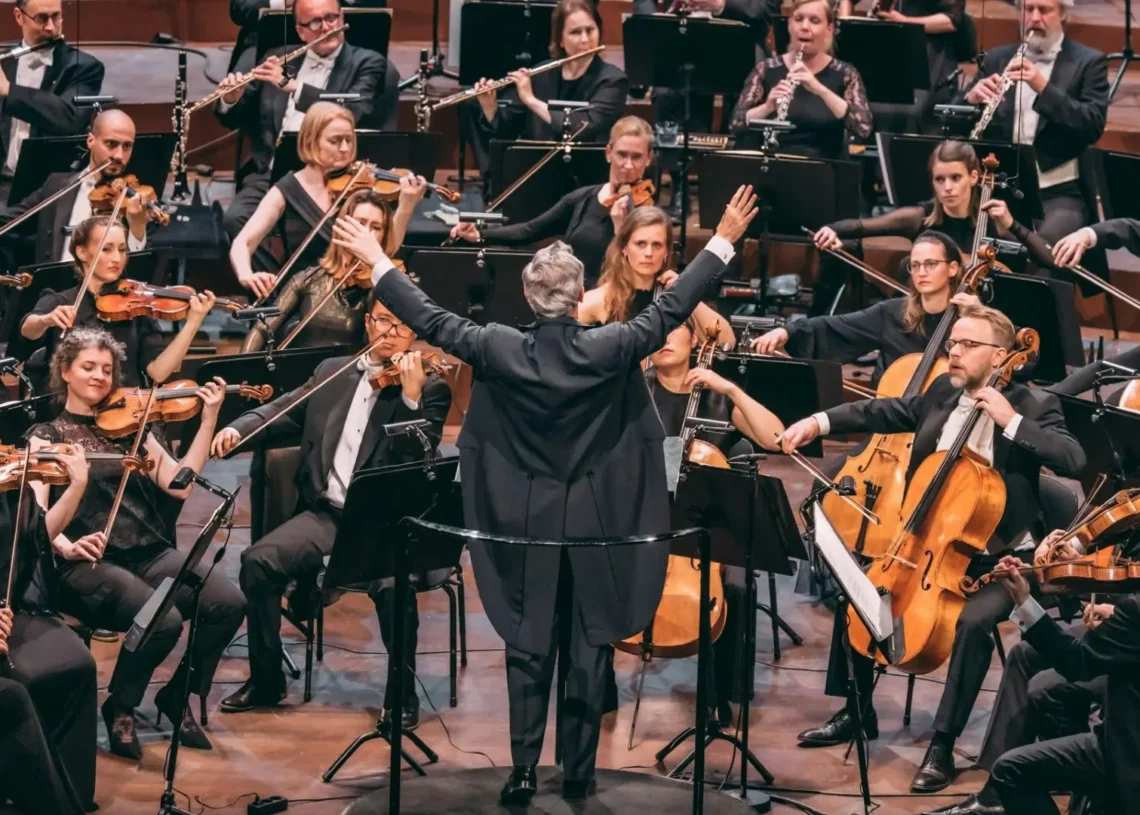Unleashing the Orchestra’s Emotional Power: Beethoven’s Instrumental Revolution
Beethoven’s symphonies are known for their deep emotional impact. He transformed the orchestra into a vehicle for expressing a wide range of feelings. Let’s explore how he used different instruments to evoke emotions and how that reshaped music.
Orchestration as a Language of Emotion
Beethoven revolutionized symphonic music by turning the orchestra into a means of expressing profound emotion. His orchestration techniques broke traditional boundaries, giving each instrument structural and expressive importance rather than focusing solely on strings or melodic lines.
In his groundbreaking approach, Beethoven assigned instruments specific roles to convey different emotions and ideas. For instance, the strings, traditionally the backbone of the orchestra, were used to express lyrical and passionate themes. The woodwinds, including flutes, oboes, and clarinets, were employed to evoke pastoral and serene moods, while the brass section, consisting of trumpets and horns, added a sense of grandeur and heroism. The percussion instruments, such as timpani and drums, were used sparingly but effectively to create dramatic accents and rhythmic drive.
One notable example of Beethoven’s innovative orchestration is found in his Symphony No. 5. In the first movement, the famous four-note motif is introduced by the strings and then passed around to different sections of the orchestra, each time with a different timbre and dynamic. This creates a sense of urgency and drama, drawing the listener into the music. In the second movement, the woodwinds take center stage, playing a gentle and lyrical melody that provides a respite from the intensity of the first movement. The brass section enters later in the movement, adding a touch of nobility and grandeur.
Another example of Beethoven’s masterful orchestration is found in his Symphony No. 6, also known as the “Pastoral” symphony. In this work, Beethoven uses the orchestra to paint a vivid picture of the countryside. The woodwinds evoke the sounds of birds and streams, while the strings create a sense of rolling hills and meadows. The brass section adds a touch of majesty to the landscape, and the percussion instruments mimic the sound of thunder in a storm.
Painting Sonic Landscapes with Instruments
In Symphony No. 6 (“Pastoral”), Beethoven used woodwinds such as flutes, oboes, and clarinets to evoke specific natural scenes and emotions, demonstrating how instrumental color could vividly paint sonic landscapes.
The symphony is divided into five movements, each depicting a different scene from country life. The first movement, “Awakening of cheerful feelings upon arrival in the countryside,” is filled with bright and cheerful melodies played by the woodwinds. The second movement, “Scene by the brook,” features a gentle and flowing melody played by the strings, accompanied by the sounds of birds and water created by the woodwinds. The third movement, “Merry gathering of country folk,” is a lively and energetic dance played by the full orchestra. The fourth movement, “Thunder, Storm,” is a dramatic and turbulent depiction of a storm, with thunderous percussion and swirling strings. The fifth movement, “Shepherd’s song. Cheerful and thankful feelings after the storm,” is a peaceful and serene melody played by the woodwinds, expressing gratitude for the end of the storm.
Beethoven’s use of instrumental color in the “Pastoral” symphony was groundbreaking for its time. He demonstrated that the orchestra could be used to create a wide range of emotions and images, paving the way for future composers to explore the expressive possibilities of the orchestra.
The Power of Silence
He also innovatively used silence and space in works like Symphony No. 5, where strategic pauses heightened tension and spatial dynamics amplified motifs.
In the first movement of Symphony No. 5, after the iconic four-note opening motif is stated, Beethoven inserts a brief but pregnant pause. This silence serves to amplify the impact of the motif, creating a sense of anticipation and unease. The listener is left hanging, wondering what will come next.
Throughout the symphony, Beethoven uses silence strategically to create dramatic tension and heighten the emotional impact of the music. In the third movement, for example, he uses a series of pauses to build suspense before the triumphant entry of the finale.
A Lasting Impact
His legacy is evident in modern conductors’ and orchestras’ approaches to balance, timbre, and emotional storytelling, where every section of the orchestra is crucial for shaping a symphony’s psychological journey.
Modern conductors and orchestras continue to be inspired by Beethoven’s innovative orchestration techniques. They strive to achieve a balance between the different sections of the orchestra, ensuring that each instrument is heard clearly and that the overall sound is cohesive and well-balanced. They also pay close attention to timbre, carefully selecting instruments and combinations of instruments to create specific colors and textures. And they use dynamics and articulation to shape the music and tell a story, just as Beethoven did.
Conductors: Navigating the Symphonic Landscape
Conductors play a crucial role in shaping the symphonic experience, guiding audiences through musical landscapes. Their influence extends beyond tempo-setting, encompassing artistic vision and audience connection.
Visionaries of the Orchestra
Orchestral interpretation and audience engagement are heavily influenced by conductors. Recent seasons highlight innovative programming, blending classic repertoire with contemporary works. Conductors curate diverse musical experiences, honoring tradition while championing new voices, thus guiding orchestras on journeys through time.
One of the key ways that conductors shape the symphonic experience is through their interpretation of the music. Conductors bring their own unique perspectives and insights to the works they conduct, and their interpretations can vary widely. Some conductors prefer to adhere closely to the composer’s intentions, while others take a more 자유로운 approach, adding their own personal touches.
Another way that conductors shape the symphonic experience is through their engagement with the audience. Conductors often speak to the audience before or after a performance, providing insights into the music and the composer. They may also lead the audience in sing-alongs or other interactive activities.
Nurturing New Talent
Beyond established maestros, there’s a growing emphasis on nurturing emerging conductors. Mentorship programs provide opportunities for young talents to hone their skills alongside celebrated musicians. This ensures that orchestral leadership remains dynamic and responsive to evolving artistic landscapes.
These programs provide young conductors with the opportunity to work with experienced mentors who can guide them in their development. They also give young conductors the chance to conduct professional orchestras, allowing them to gain valuable experience in front of a live audience.
A Multifaceted Role
Conductors leverage their authority not just musically but also educationally and culturally. They reinforce the legacy of innovation within modern symphony practice. This multifaceted role contributes to the renewed vibrancy experienced in concert halls.
They often give pre-concert talks, write program notes, and participate in outreach activities. By educating the public about classical music, conductors help to ensure that it remains a vibrant and relevant art form.
Concert Halls: Unseen Partners in Symphonic Performance
Concert halls are more than just venues; they’re integral to the symphonic experience. Architectural design and acoustic technology blend to shape how music is heard and felt, influencing both the performers and the audience.
The Science of Sound
The design of a concert hall significantly impacts the sound. A “shoebox” design, like that of the Kennedy Center’s Concert Hall, is often employed to optimize acoustics, ensuring clarity and warmth. These architectural decisions are foundational to the overall musical experience.
The shape of the hall, the materials used in its construction, and the placement of the seats all affect how sound waves travel and interact within the space. A well-designed concert hall will have a long reverberation time, which is the amount of time it takes for sound to decay after it is produced. This creates a sense of spaciousness and envelopment, making the music sound richer and more full.
Enhancing the Performance
Concert halls do more than just provide a space; they actively influence sound projection and audience engagement. Legendary performers and conductors often praise these spaces for elevating classical works, highlighting how venues contribute to the artistic outcome.
A well-designed concert hall can enhance the performance of an orchestra by providing a supportive acoustic environment. The hall’s acoustics can help to project the sound of the instruments, making them sound louder and clearer. They can also help to blend the sound of the different sections of the orchestra, creating a more cohesive and unified sound.
A Cultural Legacy
Modern concert halls blend historical tradition with new acoustic technologies. Despite some shifts in live performance attendance, ongoing investment in these venues demonstrates their vital role in preserving symphonic music’s legacy and enhancing its cultural impact.
These technologies include adjustable acoustics, which allow the hall to be tuned to different types of music, and sound reinforcement systems, which can be used to amplify the sound of the orchestra. By combining historical tradition with new technologies, modern concert halls are able to provide audiences with the best possible listening experience.
Beethoven’s Bold Moves: Redefining the Symphony’s Structure
Beethoven’s impact on the symphony is undeniable. He challenged conventions and expanded its expressive potential, paving the way for future composers. Let’s explore how he broke with tradition and reshaped the symphonic landscape.
Expanding the Orchestra’s Voice
Beethoven revolutionized the classical symphony by challenging traditional movement and form conventions. He broadened the orchestra’s dynamic and expressive capabilities through dramatic volume shifts and innovative techniques like crescendos and thematic development, creating a more emotionally impactful experience.
He made use of sudden dynamic contrasts, from whisper-soft pianissimo passages to thunderous fortissimo outbursts. He also employed innovative techniques such as the crescendo, a gradual increase in volume that builds tension and excitement. And he developed the art of thematic development, taking a simple musical idea and transforming it throughout the course of a movement, creating a sense of unity and coherence.
New Ways of Composing
Beethoven employed variation form and counterpoint, such as the double fugue in his Ninth Symphony. The integration of choral elements added complexity, intensity, and philosophical depth to the symphonic tradition, showcasing his unique approach to composition.
Variation form is a technique in which a theme is presented and then repeated in a series of variations, each of which alters the theme in some way. Counterpoint is a technique in which two or more melodic lines are combined to create a harmonious texture.
The integration of choral elements in the Ninth Symphony was a particularly groundbreaking innovation. Beethoven added a chorus and vocal soloists to the final movement of the symphony, setting the words of Friedrich Schiller’s poem “Ode to Joy.” This was the first time that a composer had used voices in a symphony, and it opened up new possibilities for the genre.
Changing the Blueprint
His structural innovations, including unconventional movement layouts and continuous thematic development, inspired composers to pursue more ambitious narratives and richer musical textures. These changes significantly influenced the evolution of orchestral and symphonic composition in subsequent centuries.
He often blurred the lines between movements, creating a sense of continuous flow. And he developed the technique of thematic transformation, in which a theme is altered and developed throughout the course of a work, creating a sense of unity and coherence.
Symphony No. 6 ‘Pastoral’: A Symphony of Nature
Beethoven’s Symphony No. 6, the “Pastoral,” offers listeners a unique experience. It moves away from dramatic symphonies to vividly evoke nature and rural life. Through orchestral color and form, it creates an immersive emotional landscape.
A Walk in the Countryside
The “Pastoral” symphony breaks from tradition with five movements, each a scene from country life. From a cheerful arrival in the countryside to a moment of thanksgiving after a storm, Beethoven guides us through nature’s beauty. He uses the orchestra to paint these scenes, creating a vivid and relatable experience.
The first movement, “Awakening of cheerful feelings upon arrival in the countryside,” is a bright and cheerful depiction of the countryside in springtime. The second movement, “Scene by the brook,” is a peaceful and serene depiction of a brook flowing through a meadow. The third movement, “Merry gathering of country folk,” is a lively and energetic depiction of a village dance. The fourth movement, “Thunder, Storm,” is a dramatic and turbulent depiction of a thunderstorm. And the fifth movement, “Shepherd’s song. Cheerful and thankful feelings after the storm,” is a peaceful and grateful depiction of the countryside after the storm has passed.
Sounds of the Natural World
Soft, lyrical wind instruments bring a gentle quality to the symphony. Dynamic shifts add depth, mirroring nature’s unpredictability. The music captures both the serenity and the restorative power of the natural world. It’s an invitation to experience the countryside through sound.
He uses the woodwinds to imitate the sounds of birds, the strings to evoke the rustling of leaves, and the brass to create the sound of thunder. He also uses dynamics and tempo to create a sense of movement and change, mirroring the ever-changing nature of the natural world.
Finding Harmony
The symphony maintains a sense of unity across its five movements. Rhythmic cohesion and thematic continuity tie everything together. This approach focuses on emotional expression rather than literal storytelling. It allows listeners to connect with the music on a deeper level.
The symphony is unified by a number of musical devices, including recurring themes, rhythmic patterns, and harmonic progressions. These devices help to create a sense of coherence and unity, even though the five movements depict different scenes from country life.
An Enduring Influence
The “Pastoral” symphony has had a lasting impact on music. It influenced how later composers approached emotion and narrative in symphonic works. It encourages conductors to explore expressive nuances and orchestras to discover new techniques for painting sound images. Even concert hall design has been shaped by this symphony’s focus on subtlety.
Q&A
Question 1: How did Beethoven fundamentally change the symphonic landscape?
Answer: Beethoven revolutionized the symphony by pushing the boundaries of orchestration, using instruments to express a wider range of emotions and creating more complex sonic landscapes. He also innovated in terms of structure and form, challenging traditional movement layouts and incorporating new compositional techniques like the double fugue. His emphasis on dynamic shifts and strategic use of silence further enhanced the emotional impact of his work, profoundly influencing subsequent composers.
Question 2: What role did the conductor, orchestra, and concert hall play in shaping Beethoven’s symphonies and their lasting impact?
Answer: Beethoven’s groundbreaking compositions demanded a higher level of skill from conductors in interpreting his complex works and from orchestras in executing his innovative orchestration. The acoustic properties of the concert hall also played a crucial role in shaping the listener’s experience. The interplay between these three elements – conductor’s interpretation, orchestra’s execution, and the concert hall’s acoustics – was essential in bringing Beethoven’s symphonic vision to life and establishing his enduring legacy.
Question 3: How did Beethoven utilize orchestration to evoke emotions in his symphonies, specifically referencing the “Pastoral” Symphony?
Answer: Beethoven masterfully used different instrumental colors to paint vivid sonic landscapes. In the “Pastoral” Symphony, he employed woodwinds to evoke specific natural scenes and emotions, creating a sense of serenity and joy. He also strategically used silence and dynamic shifts to amplify emotional impact, showcasing the orchestra’s potential for expressing a wide range of feelings beyond traditional melodic lines. This innovative approach significantly impacted how composers subsequently utilized orchestration for emotional expression.







